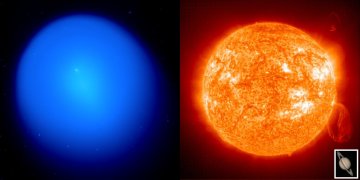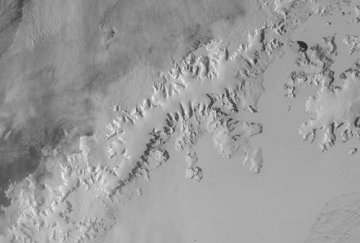 Where's Saturn? Is that a UFO--or the ISS? What's the name of that star? Get the answers from mySKY--a fun new astronomy helper from Meade. Where's Saturn? Is that a UFO--or the ISS? What's the name of that star? Get the answers from mySKY--a fun new astronomy helper from Meade. AURORA WATCH: Sky watchers, be alert for auroras. A solar wind stream is buffeting Earth's magnetic field and causing high-latitude geomagnetic storms: gallery. GIANT COMET: "Formerly, the sun was the largest object in the Solar System," says University of Hawaii astronomer David Jewett. "Now, Comet 17P/Holmes holds that distinction." On Nov. 9th, a team of Hawaii astronomers led by Rachel Stevenson measured the diameter of the comet's expanding debris cloud: 1.4 million kilometers, slightly larger than the sun itself. 
Click on the image for more information
This composite image prepared by Jewett shows a Nov. 9th photo of the comet beside the sun and Saturn for scale. To photograph the comet, Stevenson et al used the 3.6 meter Canada-France-Hawaii Telescope atop Mauna Kea, "one of the few professional instruments still capable of capturing the whole comet in one image," notes Jewett. Comet Holmes exploded on Oct. 23th and it has been expanding ever since. How big will it get? See for yourself. The comet is visible to the naked eye as a fuzzball in the constellation Perseus. With only a backyard telescope you can see the comet's debris cloud in crisp detail and watch it expand from night to night. Nov. 19th is a good night to look: The comet will glide by the star Mirfak (alpha Persei) and appear to swallow it--a sight not to be missed: sky map, ephemeris. Comet 17P/Holmes Photo Gallery
[Interactive World Map of Comet Photos]
[sky map] [ephemeris] [3D orbit] [Night Sky Cameras]
SPACECRAFT FLYBY: On Nov. 13th, Europe's Rosetta spacecraft flew past Earth, swooping a mere 5300 km above the southern hemisphere. At closest approach, Rosetta's navigation camera snapped this picture of an ice field in Graham Land, Antarctica: 
Click to view more images: #1, #2
The flyby was a gravity assist maneuver to boost Rosetta's velocity en route to Comet 67/P Churyumov-Gerasimenko. When Rosetta reaches the comet in 2014, it will drop a lander on the comet's icy surface and beam back images of frigid landscapes not unlike the one above. Antarctica is good practice for a comet. In addition to frozen sweeps, Rosetta also took some spectacular pictures of Earth's nightside, capturing city lights and possibly some auroras, too: annotated image. Inside one of those dots of light, a team of Italian astronomers (Giovanni Sostero, Ernesto Guido, Luca Donato and Virgilio Gonano) were looking back at Rosetta. Here is the view through their 18-inch telescope; Rosetta is the dim streak of light cutting through the starry background. Bon Voyage, Rosetta!
November 2007 Aurora Gallery
[Aurora Alerts] [Night Sky Cameras]
| 
